Displaying items by tag: Dragon
Local Sailing Class Success Takes Good Boats, But Even Better People
As we near the end of the traditional sailing season, inevitably there’ll be heart-searching among boat owners as to the success and value obtained from their summer afloat – can they really justify the expense of continuing to keep a boat? And with so many imponderables in our sport after a summer which was decidedly mixed in its weather - to say the least - the larger sailing community will be scrutinising those classes which seem to be barely hanging in, those classes which are doing quite well, and those few classes which are spectacularly successful. W M Nixon takes a look at the International Dragons in Glandore, the Flying Fifteens in Dun Laoghaire, and the Puppeteer 22s in Howth to try and find that magic Ingredient X which helps - or has helped - these three very different examples to stay ahead of the game.
The wish to own a boat is a vocation, a calling, a quasi-religious emotional endeavour. It’s all very well for high-flown consultants to tell us that if sailing is going to have general appeal and expand, then publicly-accessed freely-available try-a-sail boats will have to be based at every major club. But dedicated sailors know that what comes easy, goes easy. A spell of bad weather, and your jolly public groups who turned up in droves for a bit of free fun afloat will disappear like the will-o’-the-wisps they were in the first place, seeking instead to find somewhere warm and bright and out of the rain and readily providing the latest novel form of entertainment.
Meanwhile, those who are dyed-in-the-wool boat addicts will have barely noticed the idly-interested strangers coming and going. For whatever the weather, they’ve a boat to maintain, gear to repair, a crew to keep together, and some sensible purpose to find in order to give it all deeper meaning. For they know that unless they’ve a boat and her problems and possibilities occupying a significant part of their mind, they’re going to lose the plot completely.
Nevertheless, in the huge spectrum of boat ownership and sailing classes, why is there so much difference in the successful buzz created by some classes at certain localities, as opposed to the dull and declining murmur emanating from classes which are clearly on the way out?
After all, there are very few utterly awful boats afloat. No boat is completely perfect, though some may seem less imperfect than others. But in today’s throwaway world, if some class of boat is not a reasonably good representative of her general type, then she’ll never make the grade in the first place. And even in times past when news and views moved more slowly, the word soon got around if some much-touted type of boat was in truth a woofer.
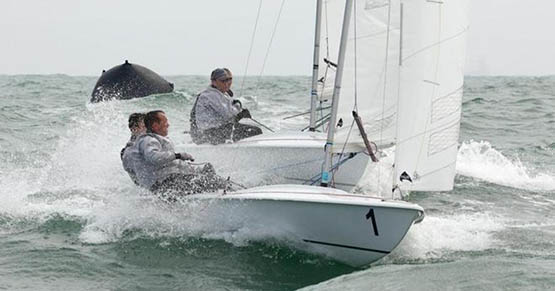
Flying Fifteens provide the best of sport in a very manageable two-man package

The perfect harbour for vintage International Dragons – Glandore, with a goodly selection of classics in port, and Dragons of all ages dotted among them
That said, boat-owning is such an all-consuming passion that once a sailor has finally (or indeed hastily) committed to a particular boat type, then he or she will tend to be absurdly dismissive of any remotely comparable craft. But in the last analysis, the desire to own a boat is irrational. So we shouldn’t be surprised that once the decision is made, irrational attitudes manifest themselves in every direction.
And anyway, as John Maynard Keynes once remarked in a totally different context, in the last analysis we are all dead. So in the meantime, it behoves us to get as much reasonable enjoyment out of life as possible. Thus if owning and sailing a boat is your way of obtaining pleasure without harming anyone else, then good luck to you and me, and let’s look together at boat classes which are doing the business.
In considering the International Dragons in Glandore, the International Flying Fifteens in Dun Laoghaire, and the emphatically not-international Puppeteer 22s in Howth, we are indeed casting the net wide, for really they couldn’t be more different. The 29ft International Dragon originated in the late 1920s from the design board of Johan Anker of Norway, and she has become a by-word for Scandinavian elegance in yacht design, but today she’s totally a racing machine and has strayed far from her original concept as a weekend cruiser for sheltered waters.
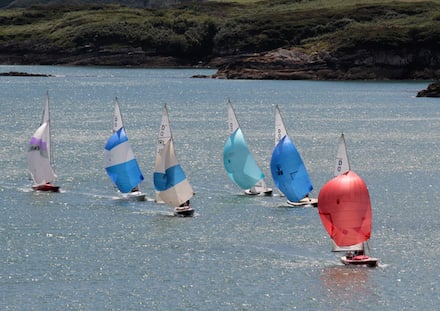
Golden days of classic Dragon racing at Glandore
As for the Flying Fifteen, they originated from designer Uffa Fox having a brainstorm in 1947, in that he took the underwater hull section of the renowned International 14 dinghy in which he was something of a master both as designer and sailor, but above the waterline he drew out the bow to an elegant curved stem, then he lengthened the gentle counter lines to finish in a long sawn-off transom. That done, he added a little hyper-hydrodynamic bulb ballast keel which seemed very trendy, but in truth it’s severely lacking in useful lateral resistance. Nevertheless it gives the boat the reassuring feel of being a small keelboat rather than a big dinghy, and atop it all he put the rig of an International 14 dinghy of that era.
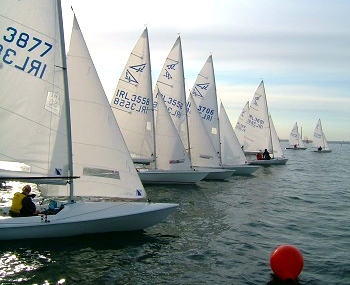
The clean lines of a modern Flying Fifteen fleet. Try to imagine that within each hull there’s an International 14 dinghy, and above it is the original rig
The result was a boat which is really only useful for racing, and it is a design so much of its times that it’s said that many years later the designer himself tried to disown it. But the owners would have nothing to do with this, they liked the compact and very manageable racing-only package which the Flying Fifteen provides, and these days the class has an interesting world spread, and an attractive policy of staging their World Championships at agreeable sunshine destinations where – thanks to their guaranteed ability to turn up with a fleet of viable size – they can arrange block discounts to provide the owners with a very appealing package.
After the sheer internationality of the Dragons and the Flying Fifteens, the Puppeteer 22s are something of a culture shock, as almost every one in existence has ended up based in Howth, where they have such a busy club programme that they only very seldom go south of the Baily, though they do have one annual adventure to Malahide for the Gibney Classic, and once a year they take part in the historic Lambay Race. But otherwise, they’re totally and intensely focused on club racing off Howth.

The Puppeteer 22s seldom stray far from their home port of Howth, for at home they get superbly close racing with a fleet of up to 26 boats in evening racing. This is former ISA President Neil Murphy racing hard at the helm of Yellow Peril, neck and neck with Alan Pearson’s Trick or Treat. Photo: W M Nixon
They were designed by Chris Boyd of Strangford Lough in the mid 1970s to be fractionally-rigged mini-offshore racers, and in all about thirty-three of the Puppeteer 22s were built by C & S Boyd in Killyleagh (Sarah was Chris’s wife). For a while it looked as though they might take off as a semi-offshore One Design class in the north, but somehow they began to trickle down to Howth. They appealed to those sailors who felt that the alternative of a Ruffian 23 with her huge masthead spinnaker was a little too demanding on crews, whereas the Puppeteer’s fractional rig is fairly easily managed. And today the class in Howth is in such good health that even in the poor weather of 2015 they were obtaining regular midweek evening racing best turnouts of up to 26 boats.
Obviously the Puppeteer 22s are now very much a completely localised phenomenom. But while the Flying Fifteens in Dun Laoghaire and the Dragons in Glandore may be representatives of well-established international classes, the fact is in both cases their neighbourhood success is largely due to a distinct local flavour driven by individual enthusiasm. And in Glandore while it’s recognized that the vintage Dragon class was started by Kieran and Don O’Donohue with the classics Pan and Fafner, the man who beats the drum these days for the racing at Glandore as providing “the best and cheapest Dragon racing in the world” is the inimitable Don Street.
Most people will expect that they will be slightly older than the boats they own, and the older you get the greater you’d expect the age gap to be. But Don’s classic Dragon Gypsy is 82 years old. Yet Don himself manages to be that proper little bit senior to her, as he’s 85 and still full of whatever and vinegar, as they’d say in his native New England.
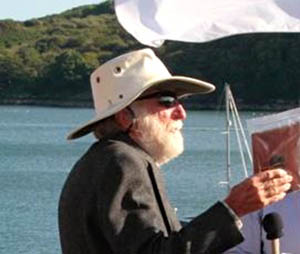
The one and only Don Street in his beloved Glandore. His International Dragon Gypsy is 82 years old, but he still manages to be the senior partner at 85.

Conditions are pleasantly sheltered for the Dragons in Glandore Harbour, but when the fleet goes offshore – as seen here for last year’s championship - they can find all the breeze and lively sea they might want, and more.
The things that Don has done with Gypsy – between intervals of the renowned ocean voyaging with his 1905-built yawl Iolaire which he has now sold – are remarkable, as he sailed Gypsy from Glandore to the classic regatta in Brittany, which is a prodigious offshore passage for an open cockpit racing boat along what the rest of the world would see as significant portions of the most exposed parts of the Fastnet Race course.
Yet although he did such wonderful business with Gypsy on great waters, he has no doubt that the secret of Glandore Dragon racing’s local success is the sheer nearness and convenience of it all. “Down to the pier and out to the boat in five minutes, the starting line is right there, and we don’t race those boring windward-leewards, rather we use club buoys, government navigation marks, islands - and lots of rocks……”
His argument is that with lovely Glandore Harbour being such an fascinating piece of sailing water, part of the interest in keeping up the pace in a local class lies in using those local features, rather than pretending they simply don’t exist by setting courses clear of the land. But of course when the Glandore fleet – which continues as a mix of classic wooden and glassfibre boats – hosts a major event such as last year’s Nationals – which was won by Andrew Craig of Dun Laoghaire in Chimaera – then the courses are set in open water, and they’d some spectacular sailing with it.
In many ways Glandore is a special case, as the population swells in summer with people coming for extended vacations. When that’s the case, their commitment to local Dragon racing can be total, and not least of the occasional local summertime alumni is the great Lawrie Smith. He may have won the Dragon Gold Cup from a fleet of 66 boats last month in Germany under the burgee of another club, but when he’s racing Dragons in Ireland, he’s emphatically under the colours of Glandore Harbour Yacht Club.
Despite these glamorous international links, it’s the folk on the home ground with their dedication to the Dragon Class in Glandore who keep it all going, and it’s Don Street with his dogged determination to prove you can run a Dragon out of pocket money, regardless of the megabucks some might be ready to splash out, which gives the Glandore Dragons that extra something. And in the end it’s all about people, and shared enthusiasm. If you’ve a warm feeling about the Dragon class, and particularly for classic boats in it, then you know that in Glandore you’ll find fellow enthusiasts and every encouragement.
But up in Dun Laoghaire, if you take a look over the granite wall on to the east boat park at the National Yacht Club in summer, and see there the serried ranks of apparently totally identical Flying Fifteens all neatly lined up on their trailers, you could be forgiven for thinking it’s all just ever so slightly clinical, and certainly distinctly impersonal.
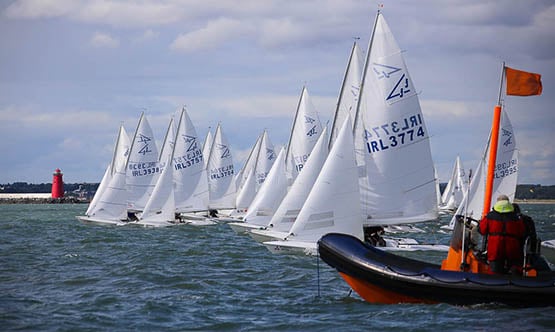
Just about as one design as they could be – the fine fleet at last weekend’s Flying Fifteen Irish Championship in Dublin Bay showed the vigour of the class, which has 47 ranked helmsmen in this country.
Yet you couldn’t be more utterly wrong. Today’s Flying Fifteens may have been technically refined to the ultimate degree to give maximum sport for the minimum of hassle. But their current runaway success – they’re far and away the biggest keelboat One Design class in Dublin Bay – is down to a friendly and very active local class association, and its readiness to reach out the hand of friendship and encouragement to anyone who might be thinking of joining the class’s ranks.
Recently the pace has been set by class captain Ronan Beirne, who recognises that simply announcing and advertising an event is not enough. You have to chivvy people and encourage them into their sailing – particularly after a summer remembered as having had bad weather – and then far from sitting back and smugly counting numbers, you have to keep at it, seeing that crewing gaps are filled, and that those on the fringes are brought to the centre.
The Flying Fifteens – which are essentially a National YC class – offer exceptional value and a very manageable package. The boats are dry-sailed in their road trailers, and instead of queuing for a crane, they have a rapid rota of slip-launching, with the expectation of renewing the wheel bearings each year. Salt water and road trailers are not good partners, but in order to ensure the most efficient launching and retrieval of the boats after each day’s racing, replacing wheel bearings has become something of an art.
The class in Dun Laoghaire secured good sponsorship from Mitsubishi Motors at the beginning of the year, and the sponsors in turn have been rewarded by a thriving class in which inter-personal friendships have developed to such a healthy state that you might find people crewing for someone who would be a complete and untouchable rival at other times in many other classes, but in the Dun Laoghaire Flying Fifteens he’s a fellow enthusiast who happens to be short of a crew on that day.
One of the enthusiastic newcomers to the class this year is Brian O’Neill, who originally hailed from Malahide and was best known for campaigning the family’s Impala 28 Wild Mustard with great success for several years, but now he’s very much a family man living in Dun Laoghaire with three growing kids, and sailing had gone on to the back burner.
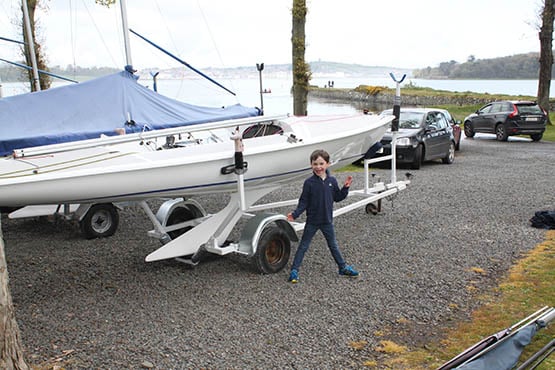
Charlie O’Neill (aged 7) at Strangford SC with dad Brian’s newly acquired Flying Fifteen. Under the rapid moving launching system at the National YC, the dry-sailed Flying Fifteens use their road trailers to get the boats afloat in record time. The need for regular replacement of the wheel bearings is allowed for in each boat’s budget. Photo: Brian O’Neill
But as the National YC is just down the road from where he lives, he was drawn into its welcoming ambience, and soon became aware of the attractive and friendly package offered within the club by the Flying Fifteens. He bought one in good order from an owner at Strangford Sailing Club in the Spring, and was soon in the midst of it. Yet it takes up only a very manageable amount of his time, it simply couldn’t be more convenient, and the people are just great too.
Who knows, but having won the class’s last evening race of the 2015 season, he might even be prepared to travel to maybe one event at another venue in Ireland. But the primary attraction continues to be the class’s strong local ethos and ready racing at the National, the friendliness of fellow Flying Fifteen sailors, and the sheer manageability of the whole thing – this is not a boat where the ownership gets on top of you.
If you want to get the flavour of Dun Laoghaire Flying Fifteen racing, you get a heightened sense of it from the report in Afloat.ie of how David Gorman and Chris Doorly won last weekend’s Irish championship in classic style, and if this isn’t good value in sailing and personal boat ownership, then I don’t know what is.
Across Dublin Bay in those misty waters of Fingal beyond the Baily, your correspondent found himself reporting aboard Alan “Algy” Pearson’s Puppeteer 22 Trick or Treat last Saturday for the opening race of the MSL Park Motors Autumn League. I did so with some trepidation, for Alan has a super young crew recruited from Sutton Dinghy Club in the form of GP14 ace Alan Blay, Ryan Sinnott and Claud Mollard, but our cheerful skipper said that as the day was brisk, they needed the fifth on board for ballast.
In fact, I’d only once raced a Puppeteer before, in the lightest of winds when somehow we managed a win. But as this race progressed with the skipper and his young tacticians making a perfect call for the long beat in a good long course which made full use of the splendid sailing waters north of Howth, by the last leg after many place changes it looked as though another win might be on the cards.

Action stations. Puppeteer 22s closing in for their start. Photo: W M Nixon
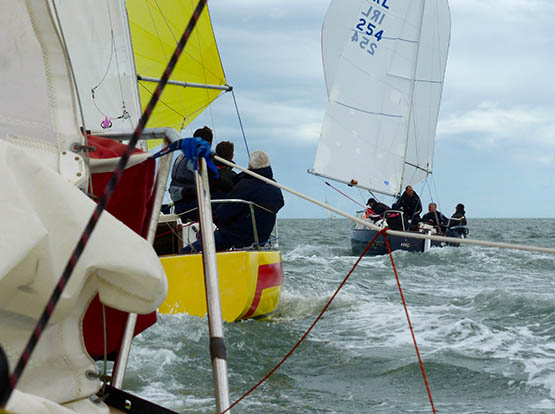
At mid-race, Gold Dust led narrowly from Yellow Peril, but by the start of the last beat, Trick or Treat was leading from Gold Dust with Yellow Peril third. Photo: W M Nixon
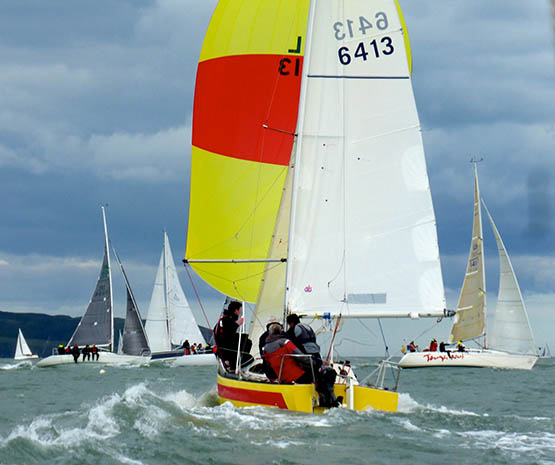
In the MSL Park Motors Autumn League, the mix of classes can sometimes make for interesting situations. Having out-gybed Gold Dust, Yellow Peril is ploughing towards some biggies on another course altogether, and meanwhile there’s the inevitable lobster pot lurking on the way with just one tiny white marker buoy. Photo: W M Nixon
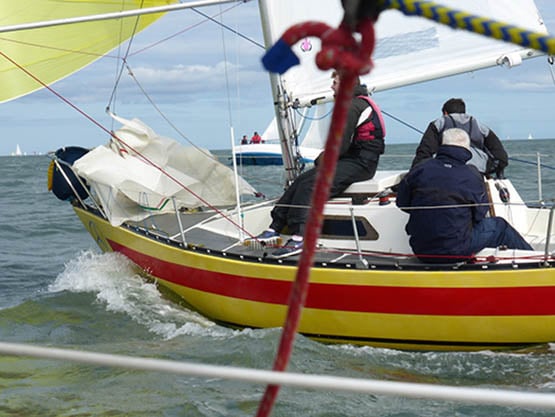
Algy Pearson’s Trick or Treat giving Yellow Peril a hard time to snatch the lead, which she then increased with a cleverly-read long beat. Photo: W M Nixon
But the pace in the Puppeteers is ferocious, and though we’d got a bit of a gap between Trick and former IDRA 14 empress Scorie Walls in Gold Dust, one sneeze from us and Gold Dust would pounce, and alas - we sneezed.
As long as we were carrying the no 2 headsail (what I’d call the working jib) we were level pegging with the formidable Walls-Browne team. But Gold Dust has a lovely new suit of sails (nice ones, Prof), and when the easing wind meant we’d to change up to the genoa, it emerged as a sail of a certain age, and having it set sapped our confidence.
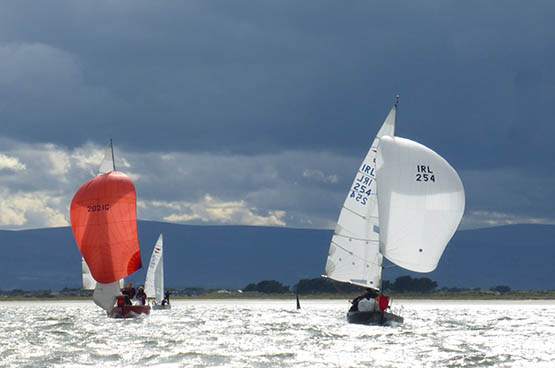
It looked for a while as though Gold Dust (254) had been put fairly comfortably astern……..Photo: W M Nixon
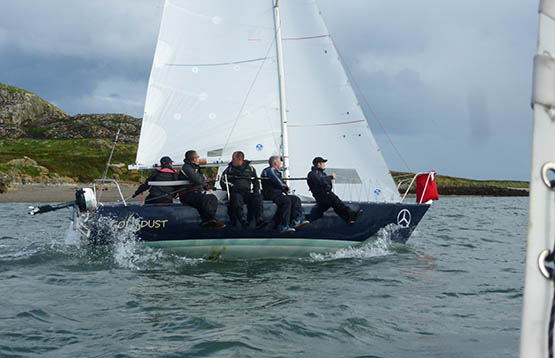
……but an easing of the wind saw Gold Dust finding new speed, and with perfect tactics she was right there with just a hundred metres to go to the finish. Photo: W M Nixon
Until then, the boat had been sailed magnificently, tactics right, trim right, and throwing gybes with such style that the downwind pace never missed a beat. But trying to get that genoa right was a mild distraction, so when Scorie the Queen of the Nile came round the final mark to chase us up the last beat to weather Ireland’s Eye, we’d failed to throw a precautionary tack to keep a loose cover, and suddenly as she rounded she found a local favourable but brief shift of 15 to 20 degrees, and then it was all to play for.
Dissecting it all afterwards (you’ll gather it was a post mortem), we could see two places where we might have still saved the day, but we didn’t grab them, or maybe in truth they were beyond our reach. Whatever, Gold Dust was in the groove and we weren’t. Madam beat us by three seconds. But the banter afterwards and the evidence that Puppeteer people – owners and crews alike – move happily among boats to keep turnout numbers up, was ample proof that here was another truly community based class which perfectly meets a strong local need.

That winning feeling…..Gold Dust’s crew relax after taking first by three seconds. Photo: W M Nixon

The Howth experience. Howth YC Commodore Brian Turvey heads back to port after racing the MSL Autumn League with the Howth 17 Isobel which he co-owns with his brother Conor. Photo: W M Nixon
It had been a great day’s sport, and the Puppeteers being of an age and regularly turning out to race together, they run both a scratch and a handicap system, which is a great improver of local classes – after all, where would golf be without handicaps?
It shows how well Gold Dust has been going this year that her rating is such that we beat her on handicap by one minute and 19 seconds, but we in turn, having been second on scratch, were fourth on handicap, where the winner was the O’Reilly/McDyer team with Geppeto.
Forty years after they first appeared, the Puppeteer 22s are giving better sport than ever, but in a very local context rather than on the bigger stage that might have been anticipated. Yet for their current owners, they do the business and then some. For most folk, this is sailing as it should be. And as to this longterm success of classes which continue to thrive whether they come from a local, national or international background, certainly the quality of the boats is important to some extent. But mostly, it’s the people involved, and their realization that you’ll only get as much out of sailing as you put into it.
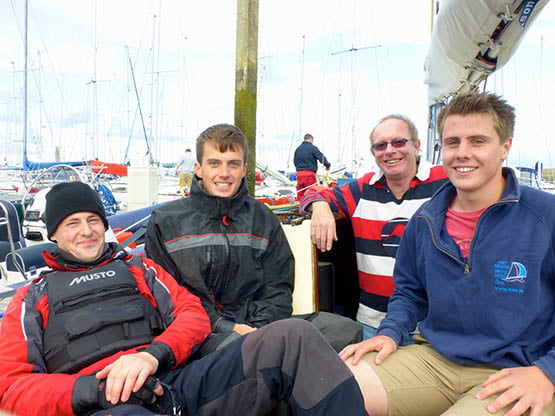
A super crew. Aboard Trick or Treat after racing are (left to right) Alan Blay, Ryan Sinnott, Alan Pearson and Claud Mollard. Photo: W M Nixon

Local man, local boat. Algy Pearson with his Puppeteer 22 Trick or Treat. The Pearsons have been sailng from Howth for three generations. Photo: W M Nixon
12–Boat Dragon South Coast Championships Begin Tomorrow
Kinsale Yacht Club welcome the Irish Dragon fleet for the 2015 Dragon South Coast Championships which begin tomorrow.
The event runs over three days with two races scheduled per day under the watchful eye of Principle Race Officer Alan Crosbie and his team.
12 entries are expected in what is likely to be an extremely competitive fleet. Title holder Andrew Craig on ‘Chimaera’ will be heading the Dublin fleet with boats expected from Glandore and the local Kinsale fleet headed by ‘Little Fella’ of Cameron Good, Simon Furney and Henry Kingston.
Light Winds Continue to Dog Dragon Edinburgh Cup
After two days of light airs trials and tribulations, the third race of the Scottish Mortgage Investment Trust Dragon Edinburgh Cup was finally completed in Largs on the penultimate day of the regatta. A lack of breeze continued to dog the event meaning only one race was possible, but that one race has ensured that the championship is now valid and a Dragon Open British Champion will be declared.
The day kicked off with a light but fairly steady south-south-westerly and after just a short postponement to tweak the course the fleet was ready to go for the long awaited race three. At the first attempt their eagerness results in a general recall, but the boats were quickly turned around and got away cleanly at the second time of asking, with the aid of the black flag.
So far.... so good. That was until the security flotilla surrounding a nuclear submarine outbound from Faslane hove into view and instructed the race committee to abandon the race and the boats to clear the area. To add insult to injury the wind began to die and it then took until late afternoon before enough wind returned to allow a re-start.
Once underway the fleet finally got to enjoy a full race in a 9-10 knot southerly. Martin Payne sailing GBR789 Bear made the best of the first beat by going right and even managed to cope with a minor drama when the weather mark went adrift just as the fleet approached and a mark boat had to recover and stand in for it. He extended his lead on the next five legs, but allowed the fleet to creep back up on him when he chose to go left on the final beat. Julia Bailey, sailing GBR720 Aimee went the other way to pull up from third to second, although she was unable to break through Bear's cover Tom Vernon sailing GBR795 Excite followed Aimee across the line with Mike Budd in GBR793 Harry fourth and Gavia Wilkinson-Cox in GBR720 Jerboa fifth.
As the Dragons finished the wind died in that area so, keen to get another race in if at all possible, the committee upped sticks and took the boats in to the channel between Largs and Great Cumbrae where a building 10-15 knot southerly was blowing. The committee attempted to set up for the fourth race but it was not to be and they sent the fleet home after another very long day on the water.
As the boats came ashore it was in the expectation that Aimee now led the regatta by three points from Jerboa with Bear one point behind in third and Bocci Aoyama sailing JAP50 Yevis II fourth. But the day's drama was far from over and back ashore Cathy Sedgeworth's GBR509 Kismet lodged a port/starboard protest against Jerboa which Kismet won. As a result Aimee continues to lead the regatta on 7 points with Bear now second on 11 points, Yeavis II third on 17 points, Patrick Gifford's GBR515 Basilisk fourth overall and leading Corinthian on 22, Excite fifth and Jerboa now sixth.
The start time for tomorrow's final day of racing has been brought forward to 10.00 and the committee will attempt to sail the remaining three races before the 15.00 final start cut off. Once a fourth race has been sailed the single discard will come into play, something both Jerboa and Excite, who was OCS in race two, will be particularly looking forward to. With so much racing still to come Aimee's four point lead is far from unassailable so tomorrow's finale promises to be a thrilling one.
Lack Of Wind Prevents Racing On Day Two Of Edinburgh Cup
#edinburghcup – Day two of the 2015 Scottish Mortgage Investment Trust Dragon Edinburgh Cup in Largs proved to be a long drawn out and extremely frustrating affair as the wind gods played cat and mouse with the fleet. After yesterday's strong winds the opposite was delivered today. Early morning brought sunny skies, unusually warm temperatures for the region and a forecast for good sea breezes in the low to mid teens. The fleet went afloat on time and with every hope of rapidly completing the two planned races, races three and four of the six race series.
At the published start time of 11.00 northerly and south easterly winds were vying for supremacy over the race area and the race committee announced the first of the day's postponements. Initially the wind looked as if it was going to favour the south east as forecast, but then it flipped back to the north and began to build. With what appeared to be a reasonably solid 7-9 knots from the same direction at both ends of the course Race Officer Chris Hadden and his team got the fleet underway smartly. All looked very good until about a third of the way up the first beat when the wind turned itself inside out and the race had to be abandoned, much to the frustration of Gavia Wilkinson-Cox in GBR761 Jerboa who was leading at the time.
The AP was rehoisted and the boats slowly drifted back towards the committee boat. By this time the sky was decidedly overcast and hopes for a true sea breeze were fading, so when the wind showed signs of stabilising from the north again the race committee immediately leapt to take advantage of it. Once again a course was set up and once again the fleet got underway. And once again they got a third of the way up the beat only to have the wind gods turn the fan off again. This time it was Martin Payne sailing GBR789 Bear who was leading when they had the rugged pulled out from under them.
There was a further period of postponement, but with conditions showing no sign of improvement and the afternoon wearing on the decision was made to send the fleet home for a much needed cold drink on the Largs Sailing Club balcony. Whilst very disappointed not to sail it was clear that the competitors were in full agreement with the race committee's decisions. "He did everything he could and the mark layers must be exhausted, but the conditions just never gave him a chance." said Martin Payne after racing. BDA Chairman Ron James, helming GBR633 Fei-Lin's Flirtation, wryly concurred, "He didn't miss an opportunity to try to start a race. There were only two and he went for it on both of them!"
As some compensation for today's missed races the competitors are this evening enjoying a wonderful Scottish Supper featuring delicious local fayre and music. The festivities opened with the Piping of the Haggis and entertainment is being provided by local folk band Heritage Soundz.
One question that has cropped up a number of times this week is why the "Edinburgh" Cup, is being raced for just outside Glasgow. To clear up any confusion we should explain that the Edinburgh Cup is so named because it was presented to the class by HRH the Duke of Edinburgh, and not because of any geographic connection with the City of Edinburgh. The Duke presented the trophy to the class, which is awarded annually to the winner of the Dragon British Open Championship, after he had been given a Dragon in 1948 by the members of the Island Sailing Club. This was also incidentally the first year in which the Dragon was an Olympic Class. The Duke was a keen sailor and his Dragon Bluebottle was to play a part in the Edinburgh Cup competition under various sailing masters, finishing second in 1954 with Lt. Commander Hewitt, second again with Graham Mann in 1956 (also the year in which Mann won an Olympic Bronze Medal in the Dragon) and third with Ross Coles in 1960. The Edinburgh Cup is rightly regarded as one of the most prestigious trophies is British yachting and a glance at the winners plaques reveals the names of many illustrious sailors.
Naturally the overall standings remain unchanged tonight with Julia Bailey, sailing GBR720 Aimee, and Gavia Wilkinson-Cox, sailing GBR761 Jerboa, on equal points at the head of the leader board with Aimee ahead on count back. Bocci Aoyama's JAP50 Yeavis is three points behind in third, Martin Payne in GBR789 Bear a further two points back in fourth and Patrick Gifford sailing GBR515 Basilisk one more point adrift in fifth overall and leading the Corinthian (all amateur) competition.
With up to six races remaining to be sailed before the regatta concludes on Friday, the Race Committee has published an amendment to the schedule to allow for up to three championship races to be sailed on Thursday and two races to be sailed on Friday. If all the championship races have been completed the second race on Friday will be the traditional Edinburgh Cup Crews Race. Tomorrow's forecast is similar to that for today and so everyone has fingers crossed that this time one of the wind directions will prevail and give some decent racing.
Ladies Rule At Larg's Dragon Edinburgh Cup
#dragon – The opening day of the 2015 Scottish Mortgage Investment Trust Edinburgh Cup in Largs certainly lived up to the Clyde's reputation for being able to deliver almost every weather condition within a matter of moments. The weather gods threw everything from less than three to almost thirty knots at the twenty strong International Dragon fleet in rapid succession and Race Officer Chris Hadden and the Scottish Sailing Institute's Race Committee did an excellent job of keeping up with the conditions to provide two terrific opening races.
By the end of the day it was no surprise to see that experience counts for a lot and in the overall standings Julia Bailey, sailing GBR720 Aimee, and Gavia Wilkinson-Cox, sailing GBR761 Jerboa, lead the regatta on equal points with Aimee just edging ahead on count back thanks to her win in the opening race.
The winner of the second race by a handsome margin was Bocci Aoyama's JAP50 Yeavis, which puts him into third overall, three points behind the ladies and two points ahead of Martin Payne in GBR789 Bear. In fifth place overall and just a single point behind Bear is Patrick Gifford sailing GBR515 Basilisk, who is also the leading Corinthian (all amateur) boat.
The day had begun with a thirty minute postponement in sub three knots. Finally the breeze filled in a little, but as the Race Committee were in the throws of starting the first race a "White water wall", as Gavia described it, rolled down the Clyde and before long the fleet were in big seas and almost 30 knots of breeze.
The first beat was close to survival conditions and the first run saw some some spectacular surfing, challenging heavy airs gybing and more than a few thrills and spills. The second lap was almost as full on and it wasn't until the third and final beat that conditions abate a little. At the line Aimee led GBR795 Excite, helmed by Tom Vernon, and Jerboa across the line with Bear fourth and Martin Makey sailing GBR704 Ganador fifth.
Race two could not have been more different with the wind down to ten knots at the start and continuing to drop and destabilise as the afternoon wore on. With the left side of the course apparently favoured, there was a lot of traffic at the pin end of the line and several people were over eager.
Sadly Excite failed to return and was disqualified, but amongst those who turned back were Jerboa and Bear who were then forced off to the right. Mike Budd's GBR793 Harry found themselves buried at the pin so also elected to tack and come off the line on port across the fleets transoms.
Yeavis meanwhile had had a clear start but tacked onto port to clear her air. They were about to tack back when crew Kasper Harsberg spotted that first Jerboa, Harry and Bear and then Mike Holmes in GBR760 Handsoff were making significant gains on the right. They made the brave decision to put all their eggs in one basket and bang the right corner. The decision was a race winner and by the first mark they had an enormous lead.
Second to round mark one was Harry with Richard Leask in GBR489 Kestra third, Jerboa fourth and Handsoff fifth. On the run Jerboa pulled up into third hard on the heels of Harry, while further back down the pack both Bear and Aimee were making rapid gains through the fleet. With the wind going right Yeavis defended their lead all the way to the finish.
Jerboa did everything she could to get through Harry and her efforts were finally rewarded in the closing moments when Harry crossed Jerboa on port but then tacked and lost momentum in the by now very light airs, allowing Jerboa to slip through to leeward for a second place. Harry finished third with Aimee snatching fourth from Patrick Gifford's GBR515 Basilisk on the final approach to the line.
With three more days and four further races still to come the regatta is wide open. The forecast promises further very varied conditions and its clear that whoever wins the 2015 Scottish Mortgage Investment Trust Edinburgh Cup and become British Dragon Champion will have had to work very hard to do so. Weather permitting races three and four are scheduled for tomorrow starting at 11.00 and if both races are completed the single discard will come into play.
Julia Bailey Wins 2015 Dragon Scottish Championship
#dragon – Twenty of the top International Dragon crews are gathered in Largs for the 2015 Scottish Mortgage Investment Trust Dragon Scottish Championship and Edinburgh Cup. The regattas, which take place from 27 June to 3 July, have attracted competitors from across the UK and as far afield as Japan.
After three days and five thrilling races the Scottish Mortgage Investment Trust Dragon Scottish Championship concluded on Monday evening with the trophy being awarded to Julia Bailey, Keith Tippell, Will Heritage and Pedro Andrade sailing GBR720 Aimee. Team Aimee arrived in Largs as the defending Edinburgh Cup Champions having won both the overall and Corinthian Edinburgh Cup Trophies in Lymington in 2014 with Julia's husband Graham at the helm. Graham was unable to attend this year's regatta so it was Julia's turn to take the helm and she roped in old friend Pedro to complete their team.
From the opening race Cowes based Julia put her stamp on the regatta showing impressive boat speed and tactical superiority. She won three out of the five races and finished third in another with the only blot on her copybook being an OCS disqualification in race two, when she failed to realise she was on the wrong side of the start line.
Julia's nearest rival was Martin Payne from Cornwall, sailing GBR789 Bear with crew Gillian Hamilton and Donal Small, whose constantly improving scoreline of 4, 2, 2, 1 left them three points behind Julia, but clearly still in firm contention for the coming Edinburgh Cup.
Third place overall and the Corinthian Scottish Championship Trophy, for all amateur crews, was awarded to Patrick Gifford of Angus sailing GBR515 Basilisk with his son Michael and guest crew Martin Spall. Patrick was understandably happy with their achievement as their boat is 29 years young and this was the first time they had raced with Martin in the boat.
For Julia her victory was particularly sweet as she noted, "My Grandfather Machlachlan would have been very proud to know that his granddaughter had won the Dragon Scottish Championship." At the prize giving she also paid tribute to the excellent race management provided by the Scottish Sailing Institute's Race Committee headed by Race Officer Chris Hadden, the outstanding quality of the Clyde's sailing waters and the warm Scottish hospitality that has been extended to the competitors since they arrived at Largs Sailing Club.
On Tuesday morning the fleet will begin racing for the Edinburgh Cup, which was presented to the class by HRH The Duke of Edinburgh in 1949 and is awarded annually to the British Open Dragon Champion. Racing will continue until Friday 3 July with up to six championship races plus a crew's race scheduled.
Joining the fleet for this second part of the competition will be a number of top crews including Gavia Wilkinson-Cox sailing GBR761 Jerboa with Mark Hart and Philip Catmur; Tom Vernon sailing GBR795 Excite with Adam Bowers and Oliver Spensley-Corfield; Mike Budd sailing GBR793 Harry with Mark Greaves and Sam Gardiner; and Ron James sailing GBR633 Fei-Lin's Flirtation with Julia Walsh and Mark Pettit.
The Edinburgh Cup is one of sailing's most prestigious trophies and with four days of top level racing ahead of us it promises to be an extremely close competition. Regular updates, results, photos and videos will be posted to the British Dragon Association Blog and via the British Dragons at Facebook.
#dlregatta – With the Kinsale ICRA Nats/Sovereigns Trophy 2015 very successfully concluded last weekend, and a classic Dun Laoghaire to Dingle Race put stylishly in place before that, the feeling of another sailing summer busily in progress is all-pervasive. But while the image projected may well be one of stately progress by the cruiser-racer fleets along the Irish coast, taking in an offshore race here and a regatta there with much leisurely cruising in between, the reality is usually otherwise. For those boats doing significant segments of the programme, it's a case of fitting chosen events into the usual hectic early summer life of work and family commitments and exams and everything else, with the re-location of boats to the next venue being a hurried task undertaken by delivery crews.
Next week sees the mid-season peak of the sailing summer, with the four day Volvo Dun Laoghaire Regatta 2015 in Dublin Bay from Thursday July 9th to Sunday July 12th. In a way it is an amalgamation of all that has has already occurred in this year's season, together with new elements to make it a unique sailfest which celebrates the fact that the citizens of Ireland's capital city and their guests can be conveniently sailing and racing within a very short distance of the heart of town. W M Nixon sets the scene
In the dozen or so years since its inception, the biennial Volvo Dun Laoghaire Regatta has settled itself firmly into the sailing scene as an exceptionally varied event in terms of the boats and classes taking part. There are five regular cruiser-racer classes, plus an offshore division, fourteen one design keelboat classes, and nine dinghy classes. And although there are contenders from Ireland's north coast and from the Cork area and south coast too, together with one gallant entry from Galway, it is essentially an Irish Sea Sailfest, though with a remarkably strong Scottish presence.
However, it was on the coast of Wales at 8.0pm last night that this sailing celebration began, with an ISORA Race starting in Holyhead and heading for Dun Laoghaire to set this large and complex programme into action towards a culmination on Dublin Bay in eight days time with the conclusion of VDLR2015.
2015 marks the Bicentennial of the Royal Dee YC, which was founded in 1815 on the Cheshire shores of the River Dee estuary where northwest England marches with northeast Wales. Originally the Dee Yacht Club (and founded, it's said, a month or two before the Royal Yacht Squadron came into being in the south of England, making the RDYC the second-oldest Royal yacht club in England after the Royal Thames), the Cheshire club became the Royal Dee YC in 1847.
Although the great prosperity of Liverpool in the 19th century saw the club's fleet of substantial yachts gathered in the Dee and then increasingly in the Mersey, by the late 1900s it was looking to the Menai Straits area as the focus of its keelboat events. As well, the completion of Holyhead breakwater in 1873 added a new and important harbour to its list of possible big boat sailing locations, and there was an increase in the number of cross-channel "matches" which the Royal Dee and the Royal Mersey, in conjunction with the Dublin Bay clubs, had already been running for some years.

A Royal Alfred YC cross-channel match from Dublin Bay to Holyhead gets under way in 1888. Cross-channel links were strong in the latter half of the 19th Century, and with the new breakwater completed at Holyhead in 1873, a new venue was available both for the Irish clubs and those on the other side such as the Royal Dee and the Royal Mersey

The bicentenary logo of the Royal Dee YC. In 1815, this club on the Cheshire coast was founded shortly before the Royal Yacht Squadron in the souh of England, whose Bicentennial is being celebrated at the end of July.

Dun Laoghaire saw its first regatta staged in 1828, and participation by yachts from the northwest of England and North Wales was regularly recorded. This is the Royal St George YC regatta of 1871.
So when we say that the Royal Dee has always been a stalwart of offshore racing in the Irish Sea, we're not referring to a story spanning only the 20th and 21st Centuries. On the contrary, it goes well back into the 1800s. And now, with the revival of keelboat sailing in the Mersey with several of Liverpool's myriad docks being given over to recreational use, we have in a sense come full circle with enthusiastic Dublin Bay support of the Bicentennial celebrations reflecting sailing links which go back almost 200 years
The Lyver Trophy is the Royal Dee's premier offshore challenge, and this year it is special, as it's a fully-accredited RORC event counting for points in the annual championship, and a highlight of the ISORA Programme 2015. It's start scheduled for yesterday evening in Holyhead will see the fleet – mostly regular ISORA contenders – sail a course of at least a hundred miles before finishing in Dun Laoghaire. Then as VDLR 2015 gets under way, races in it, combined with the Lyver Trophy results, will count as part of a series towards finding an overall winner of the RDYC Bicentennial Trophy.
Only entrants in the Lyver Trophy race are eligible, and for that race itself – which can be followed on the Averycrest Yellowbrick Tracker - the favourite has to be the Shanahan family's J/109 Ruth, still buoyed up by her great victory in the Dun Laoghaire to Dingle Race three weeks ago.

Back in The Bay – the Shanahan family's J/109 Ruth will be back in her home waters of Dublin Bay after winning the Dun Laoghaire to Dingle Race and completing the Lyver Trophy Race from Holyhead which started last night. Photo: David O'Brien
At the other end of the size scale, the VDLR2015 Dublin Bay programme includes several dinghy classes, and the biggest fleet will be mustered by the International GP 14s, who have designated the racing in Dublin Bay as their Leinster Championship. In an interview with Sailing on Saturday in March, VDLR Chairman Tim Goodbody emphasised that, overall, the event should be seen as a regatta rather than a championship, and for most boats that's just what it will be. But the GP 14s with their great esprit de corps have always done things their own way, and with their compact boat size – albeit comprising a large fleet of dinghies – they reckon they can get in a proper championship while sharing in the fun of the event.
 The brothers John and Donal McGuinness of Moville Sailing Club in Donegal are expected to be among the pace-setters in the GP 14 class with their superb Alistair Duffin-built boat. Photo: W M Nixon
The brothers John and Donal McGuinness of Moville Sailing Club in Donegal are expected to be among the pace-setters in the GP 14 class with their superb Alistair Duffin-built boat. Photo: W M Nixon

The GP 14 Ulsters 2015 were recently won on Lough Erne by Shane MacCarthy & Damian Bracken of Greystones
As to who is favourite, the McGuinness brothers – Donal and John - from Moville in Donegal, with their top-of-the-line Duffin boat built in Northern Ireland, have to be in the reckoning after being top Irish at last year's Worlds on Strangford Lough, but there's fresh blood in the fleet with the newest class developing at Youghal, while this year's recent Ulster Championship on Lough Erne was won by the Greystones duo of Shane MacCarthy and Damian Bracken.
The dozen and more boats coming south from Scotland, most of them substantial cruiser-racers, are testimony to a growing trend in sailing on Europe's Atlantic seaboard. Given a choice of venues, your average yachtie on this long coastline will incline to head south if at all possible. Other things being equal, it's reckoned the further south you go the warmer it is likely to be. And from the upper reaches of the Firth of Clyde, there are times when Dublin Bay might seem like the distant and sunny Mediterranean.
Maybe so, but we'd caution that much depends on the moods and location of that all-powerful weather determinant, the northern Polar Jetstream. In July, so long as it's well clear of Ireland -whether to the north or the south - we will have glorious high summer, and that occurred for the previous VDLR back in 2013, where the photos speak for themselves.
So we hope for the best in looking forward to welcoming a fleet of around 415 boats to Dun Laoghaire between July 9th and 12th, with all four of our in-harbour yacht clubs extending the hand of hospitality in a regatta tradition that goes right back to 1828. But while heritage and ceremonial are all very well in their place, it's the prospect of good sport which energises the participants and their sailing, and with several major contests already logged in 2015, what can we expect on the leaderboards next week?
At the top of the tree, Class 0 has formidable competition, including former Scottish champion Jonathan Anderson racing his XP38i Roxstar against the Royal Cork's Conor Phelan with the Ker 37 Jump Juice, which was one of the best performers in last year's ICRA Nationals at the same venue, and this year again became a force to be reckoned with as the breeze sharpened in the four day Kinsale ICRA Nats 2015/Sovereigns Cup a week ago.
 Freshly squeezed – her storming finish to last weekend's final race of the ICRA Nats/Sovereigns Cup at Kinsale makes Conor Phelan's Ker 37 Jump Juice one of the top contenders in the VDLR2015. Photo: David O'Brien
Freshly squeezed – her storming finish to last weekend's final race of the ICRA Nats/Sovereigns Cup at Kinsale makes Conor Phelan's Ker 37 Jump Juice one of the top contenders in the VDLR2015. Photo: David O'Brien
With a win in the final race, Jump Juice came in second to seasoned campaigner George Sisk's class overall winning Farr 42 WOW (RIYC), the pair of them in turn displacing the early leader, lightweight flyer Mills 36 Crazy Horse (ICRA Commodore Nobby Reilly & Alan Chambers, HYC) down to third in the final day's racing, so Crazy Horse will be hoping for a return of lighter breezes when racing starts next Thursday on Dublin Bay.
In the previous Volvo Dun Laoghaire Regatta in 2013, the most successful boat in was Nigel Biggs' much-modified Humphreys Half Tonner Checkmate XV, but this year the Biggs team is racing as Checkmate Sailing with the newest boat in the fleet, the Mark Mills-designed American-built C & C 30 OD Checkmate XVI. She may be only 30ft LOA, but she's such a hot piece of work with so many go-fast bells and whistles that she has a rating of 1.140 to put her in Class 0.
The oldest boat in the cruiser-racer fleets will be found in Class 3, where the 44ft Huff of Arklow is making an historic return to Dublin Bay racing. Originally built in 1951 by Jack Tyrrell of Arklow to a design by dinghy genius Uffa Fox, Huff is so-called because her concept is reckoned three-quarters Uffa Fox and one quarter Douglas Heard. The latter was the founding President of the Irish Dinghy Racing Association in 1946, and he later went onto to become Commodore of the Royal St George YC and a noted cruising and offshore racing enthusiast with this unusual boat, which is like a very enlarged Fying Fifteen with a lid – in fact, with her 30ft-plus waterline, she was described as a Flying Thirty. In recent years she has undergone a total restoration with Cremyll Keelboats near Plymouth in Devon, and Dominic Bridgeman of the Cremyll group will be racing her with trainee crews in her old home waters of Dublin Bay.

The Flying Thirty Huff of Arklow racing off Dublin Bay while under Douglas Heard's ownership in the 1950s. Built by Tyrrell's of Arklow in 1951, the hugely innovative Huff has recently had a major restoration, and will be making her return to Dublin Bay to take part in VDLR2015.
Among the newer boats on the bay, the 2013 champion Checkmate XV is still very much in the picture, but now she's owned by Howth's Dave Cullen, and took second overall in class in the Kinsale series a week ago. In Dun Laoghaire next week, she's with other Half Tonners at the lower end of the Class 2 rating band on 0.944, almost 200 rating points below the new Biggs boat. Class 2 also includes the Division 3 winner at Kinsale, Richard Colwell & Ronan Cobbe's Corby 25 Fusion (HYC) which bested VDLR 205 Chairman's Sigma 33 White Mischief in a real duel after they went into the final day's racing equal on points, while another Kinsale success story in the Class 2 lineup is Paddy Kyne's X302 Maximus from Howth, overall winner of the Portcullis Trophy for top ECHO boat.

Dave Cullen's modified Half Tonner Checkmate XV will be looking to take the top slot on Dublin Bay after being runner-up in Kinsale. Photo: David O'Brien
In between the two Checkmates on ratings, we find most of the cruiser-racer fleet, with Class 1 shaping up some interesting competition between the likes of Paul O'Higgins Corby 33 Rockabill (RIYC), Kenneth Rumball skippering the Irish National Sailing School's Reflex 38 Lynx, and two very sharp First 35s, Prima Luce (Burke, Lemass & Flynn, NYC & RIYC) and another former Scottish Series champion, John Corson (Clyde Cr C) with Salamander XXI.
This year's Scottish Series Champion and the Afloat.ie "Sailor of the Month" for May, Rob McConnell of Dunmore East, will certainly be racing in the VDLR 2015, but whether or not it's with his all-conquering A35 Fool's Gold (second in class at Kinsale) or aboard another boat (a Flying Fifteen) remains to be seen. And the Top Sailor Count doesn't end there, as there'll be at least four Olympic sailors involved in four different classes, with Robin Hennessy racing in what has all the marks of a quality International Dragon fleet against the likes of former Edinburgh Cup winner Martin Byrne, Annalise Murphy racing in the Moths which will surely be a change from the Water Wag which she raced with her mother Cathy MacAleavy (also another ex-Olympian) last time round, and Mark Mansfield helming John Maybury's J/109 Joker 2. After Joker 2's class overall win in Kinsale, we can expect a battle royal in the J/109s with boats of the calibre of Ruth for the National title fight.

The Shipman 28s find that the sport and socializing which the VDLR guarantees will provide some of their best racing of the year. Photo: VDLR
The J/109s are the queens of an impressive array of One Design keelboats which includes Sigma 33s (where VDLR 2015 Chairman Tim Goodbody's White Mischief is racing under the command of Paul McCarthy), Beneteau First 31.7s, Shipman 28s having one of their best gatherings of the year, Ruffian 23s with a good turnout, the attractive First 21s which are steadily gaining traction as a Dublin Bay class, and best OD keelboat turnout of all is by the Flying Fifteens, nearly all of them under the NYC flag.

Olympians all – in VDLR2013, Olympic sailors Cathy MacAleavey (1988) and her daughter Annalise Murphy (2012) raced the family Water Wag Mollie. But while Cathy will be sailing Mollie again this year, Annalise will be on her own racing a foiling International Moth.

Newest of the oldest – Adam Winkelmann and Doug Smith's new French built Water Wag No.46, Madameoiselle, has been launched in time for the regatta. Photo: Owen McNally

The Howth 17s of 1898 vintage will be the oldest class racing. Photo: David Branigan
Veteran classes include the IDRA 14s from 1946, the Glens from 1945, the Howth 17s of 1898 which pre-date the 1902 Water Wags, and the 1932 Mermaids, the latter being in the interesting position of no longer having an official division in Dun Laoghaire, yet it's a Dun Laoghaire skipper, Jonathan O'Rourke of the National, who continues to dominate the class both at home and away.
With large fleet numbers afloat guaranteed, the shoreside programme is appropriately busy, with the official side of each day's racing concluded by the evening's daily prize-giving at one of the four waterfront clubs. But with so many sailors involved, there'll be action in all the clubs – and at other establishments in Dun Laoghaire - throughout the week. The scene is set, let the party begin at a venue which has been staging regattas since 1828.
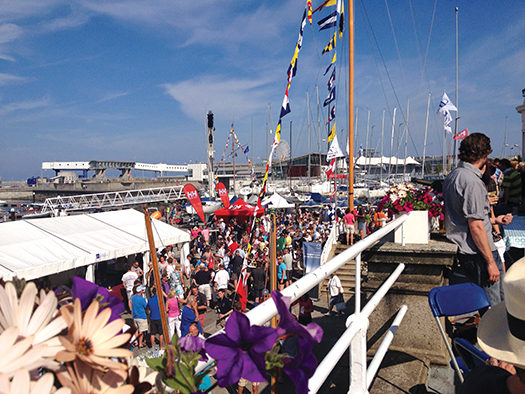
When the summer comes, the après sailing at the VDLR is world class. Photo: VDLR
Further reading:
Download the full entry list for Dun Laoghaire Regatta 2015 class by class below
Download the Sailing Instrcutions for Dun Laoghaire Regatta 2015 HERE
- Dun Laoghaire Regatta
- Volvo Dun Laoghaire Regatta
- Royal St George Yacht Club
- Royal Irish Yacht Club
- National Yacht Club
- ISORA
- Water Wags
- Royal Alfred Yacht Club
- yellowbrick
- GP 14
- Nigel Biggs
- George Sisk
- Annalise Murphy
- Half Tonners
- Tim Goodbody
- Mermaid
- Fool's Gold
- Dragon
- Irish National Sailing School
- Kenneth Rumball
- Dublin Bay
Dragons Converge On Largs For 2015 Scottish Championship
#dragon – The British Dragon Fleet is currently converging on Largs, Scotland for the start of the 2015 Dragon Scottish Championship and the Scottish Mortgage Investment Trust Edinburgh Cup, which get underway this Saturday 27 June. The twenty strong fleet of Dragons from across the UK and as far afield as Japan but unfortunately none from Ireland is making a historic return to Scotland, which last hosted the Edinburgh Cup back in 2003.
The events are organised by Largs Sailing Club in association with the Scottish Sailing Institute and the British Dragon Association. Racing for the Scottish Championship takes place from Saturday 27 to Monday 29 June with up to five races scheduled. The Scottish Mortgage Investment Trust Edinburgh Cup, for the Dragon British Open Championship, will be raced from Tuesday 30 June to Friday 3 July with up to six championship races scheduled.
The Dragon's connection with Scotland goes back to the very start of the class in the UK in 1933 when A H Ball, a member of the Clyde Yacht Club, was on a cruising holiday in Scandinavia, where he was much taken with the design of the Dragon. He returned from his holiday with a copy of the plans and the idea of establishing a class caught on. The first Dragon to come to Britain was Anita in 1936, owned by J.Howden Hume. The same year McGruer built 9 Dragons at Clynder and regular class racing began with 14 boats, including an international regatta won by a Swedish boat.
In recent years the Dragon fleet in Scotland had dwindled, but interest is once again growing in Scotland, which has precipitated the running of the Scottish Championship for the first time in over a decade and the return of the Edinburgh Cup north of the boarder. The fleet is delighted to welcome four Scottish Dragons to the events in the shape of Henry Boyd's GBR343 Wizz Too, Richard Leask's GBR489 Kestra, Cathy Sedgeworth's GBR509 Kismet and British Dragon Association Chairman Ron James sailing GBR633 Fei-Lin's Flirtation. All four of these boats will be racing under the flag of the Royal Forth Yacht Club.
Leading the visiting fleet is defending Edinburgh Cup Champion Julia Bailey at the helm of GBR720 Aimee. Julia is also the current Corinthian Edinburgh Cup Champion, the element of the competition open to all amateur crews, and will be very much hoping to become the first person to ever won consecutive Edinburgh Cups in both overall and Corinthian divisions. Others who have the potential to prevent Julia in achieving her aims include Martin "Stavros" Payne at the helm of GBR586 Full Speed, who first engraved his name on the Edinburgh Cup in 1999 and will be hoping to do so again this time out; Gavia Wilkinson-Cox sailing GBR761 Jerboa, who has come close to claiming this prestigious trophy on several previous occasions and must surely feel that this year its her turn to be the bride; and Mike Budd, who already has a number of dinghy national championships to his name and travels to Largs from Abersoch with high hopes of adding the Edinburgh Cup to his CV.
Racing will take place on windward leeward courses to the north of Great Cumbrea Island and there will also be an excellent programme of social events with the Scottish hosts going all out to prove that their reputation of great hospitality is well deserved.
Sailing the Enduring Dragon Keelboat on Irish Waters
#dragonsailing –After a weekend of intense Dragon keelboat action on Dublin Bay, Class Captain Conor Grimley writes that after eight decades in the making, the Dragon class is breathing new fire into the Irish sailing scene – and it’s much more accessible than it appears
The Dragon class has never been so strong in international waters as it is today. At over 80 years old, the classic design has endured – and its popularity has ensured that build quality is second to none.
True enough, the class has been somewhat elusive on the domestic scene, with international competitions tending to take precedence over regional events and club racing.
Still, the Irish Dragon fleet has a strong core spread between Dublin Bay, Kinsale and Glandore, where Corinthian sailors mix it with professionals, providing for exciting racing.
Into the bargain is the fact that newer boats don't have it all their own way, such is the quality of older models. And now momentum is coming back to the domestic scene as well.
Take the eighth and final race of the 2014 season at Kinsale, where Lawrie Smith, the Whitbread Round the World legend and current Irish champion, pipped the all-amateur Dublin Bay crew of Phantom – a 10-year-old boat – in a virtual photo-finish. You can't get better than that for club sport.
Sleek design
There are few better sights in yacht racing than the sleek lines of a fleet of Dragons, with their beautiful hull shape and timeless sail plan.
To sail one is just as great a pleasure. Surprisingly responsive at the helm, the Dragon moves beautifully upwind and downwind in all conditions. If a little over-canvassed in heavier conditions, simply drop the main sheet down the track, crank on more running backstay, and you'll find its performance is very reassuring indeed.
Crew weight is a consideration, but it's not the whole story – and over time Dragon sailors develop a strong body core. Sail trim is aided by fine-tuning on the main and genoa sheets.
Contemporary designs are brilliantly thought-out overall, with modern-specification rigging systems that are second to none.
Running costs
Appropriately enough, the basic running cost of the Dragon sits midway between that of dinghy keelboats and cruiser-class yachts.
At eight metres, it is bigger than the average six-meter dinghy keelboat but a tad smaller than the nine-meter cruisers. The Dragon is dry-sailed, and club parking, like marina berths, tends to be priced on a per-metre basis, so size really counts here.
A new suit of sails for the average Dragon costs up to €5,500 for genoa, spinnaker and main. The difference? That’s about 30 per cent up from the keelboat dinghy, but 30 per cent less than what you’d pay for cruiser racer sails. Again, there’s nothing unfair in any of that. In fact, these figures may come as something of a surprise. Dragon sailors, however, bemoan the common observation that it’s a beautiful boat but unduly expensive.
Outlay
So where’s the catch? Well, a new Dragon, complete with its wonderful German-made trailer, will set the buyer back a cool £82,500 but like any boat there is great value to be had in the second–hand market where a race ready competitive boat could be found for as little €18000.
So yes, a brand new Dragon is not a giveaway, but endure they most certainly do. The level of build quality is truly a testament to the strong professional interest globally that’s driven innovation in the class, particularly over the past 10 to 15 years.
The future
Corinthian sailor Tim Pearson of the Royal St George Yacht Club takes over as international class secretary in 2015, a measure of the esteem in which the Irish fleet is held.
He takes up his role at a time when the class is having much debate about the balance between the amateur side and the professional, where there is no shortage of worldwide participation.
Both sides are expected to mix it up in the busy 2015 season that awaits. Moreover, the endorsement of Kinsale for the 2019 Gold Cup raises the incentive for one of the international fleet's great events to return to Irish waters.
“Another challenge everywhere,” says Pearson, “is to encourage more owners in the 37-year-old age bracket.”
Undoubtedly, changing lifestyles and a proliferation of yacht designs are challenges in themselves to all yacht racing, the Dragon included. But the issue of cost may be particularly misrepresented for this class.
Peter Bowring, co-owner of Phantom, concurs. “The Dragon fleet has possibilities for all comers,” he says. “We just have to fly the ‘D’.”

Close competition during the 2015 Dragon East Coasts – Photo: Michael Keogh
Irish Dragon fleets
Dublin Bay: The Dublin Bay Dragon fleet had 15 active boats in 2014. Not all boats opt to register for club sailing, although the National Championships in Dublin and the Dun Laoghaire Regatta looks set to change that in 2015.
Kinsale: The Kinsale Dragon fleet has a long-standing tradition of competition, and the popularity of the Cork town saw an influx of Abersoch-based Dragons for the 2014 Irish Nationals. In 2012, Kinsale hosted the prestigious Dragon Gold Cup, and the success of that event looks set to win the endorsement of the International Dragon Association for the 2019 event.
Glandore: The Dragon and Glandore are a long-standing family tradition. The fleet celebrates its Corinthian legacy, and the annual Rose Bowl Trophy is often an all-Cork affair between the Kinsale and Glandore fleets. Before the establishment of the Glandore Harbour Yacht Club, the South Coast Championships, which moves by rotation with Kinsale, was hosted by the local hotel.
DRAGON KEELBOAT SPECIFICATIONS
Hull Type: Fin Keel
Rig Type: Fractional Sloop
LOA: 29.17' / 8.89m
LWL:19.00' / 5.79m
Beam: 6.42' / 1.96m
Listed Sail Area: 286 ft2 / 26.57 m2
Draft (max.) 3.92' / 1.19m
Disp. 3740 lbs./ 1696 kgs.
Ballast: 2200 lbs. / 998 kgs.
Designer: Johann Anker
Construction: Wood or FG
First Built: 1928
This article also appears in Summer Afloat magazine 2015
Royal St. George Entry Continues Dragon Championship Lead
#Dragon – Local sailors continue to lead the Dragon National Championships in Dun Laoghaire this morning. After six races sailed in the 13–boat fleet David Williams and Peter Bowring are three nett points clear of Kinsale's Cameron Good on 15 points as the event reaches its conclusion in gusty north–westerly conditions on Dublin Bay. Full results after six races at the National Yacht Club are below.
Dragon Nationals after six races sailed
Rank Fleet Boat SailNo Club Skipper Race 1 Race 2 Race 3 Race 4 Race 5 Race 6 Total Nett
1st PHANTOM IRL 176 R.STGYC BOWRING/WILLIAMS 2.0 (4.0) 1.0 4.0 4.0 1.0 16.0 12.0
2nd LITTLE FELLA IRL 211 KYC GOOD FURNEY KINGSTON 4.0 2.0 5.0 2.0 (6.0) 2.0 21.0 15.0
3rd CHIMAERA IRL 216 R.STGYC ANDREW CRAIG 3.0 (5.0) 3.0 3.0 3.0 3.0 20.0 15.0
4th BEAR ESP 71 SALCOMBE MARTIN PAYNE/ 1.0 6.0 4.0 (10.0) 1.0 4.0 26.0 16.0
5th JAGUAR IRL 201 R.STGYC MARTIN BYRNE 5.0 7.0 6.0 (13.0) 2.0 6.0 39.0 26.0
6th DUBLIN BAY IRL198 R.STGYC MAXWELL TRACY 12.0 3.0 7.0 1.0 (14.0 RET) 7.0 44.0 30.0
7th ZU IRL 214 R.SRGYC TIM PEARSON 6.0 1.0 8.0 (12.0) 7.0 8.0 42.0 30.0
8th BASILISK 515 ALDEBURGH PATRICK GIFFORD (14.0 RET) 14.0 DNC 2.0 5.0 5.0 12.0 52.0 38.0
9th DIVA 210 RIYC R.GOODBODY 8.0 (11.0) 9.0 8.0 8.0 5.0 49.0 38.0
10th TENACIOUS IRL 157 KYC ANTHONY O.NEILL 9.0 8.0 (12.0) 6.0 9.0 9.0 53.0 41.0
11th DECISION IRL195 R.STGYC J.MASON 7.0 10.0 10.0 7.0 10.0 (13.0) 57.0 44.0
12th ZinZan 127 RIYC TIM CARPENTER 10.0 9.0 (13.0) 11.0 11.0 11.0 65.0 52.0
13th AMSTAD GBR 585 R.STGYC RONAN MURPHY 11.0 12.0 11.0 9.0 (14.0 RET) 10.0 67.0 53.0
























































